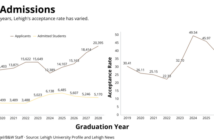While pursuing the humanities and social science sections of any library, you’re likely to come across a laundry list of politically-charged and contested terms: white privilege, male privilege, the gender gap, heteronormativity, rape culture, American exceptionalism and first world problems.
Well, okay, maybe not that last one.
These highbrow phrases – coined by sociologists, historians, social commentators and the like — have driven many intellectual discussions on the state of equality in our contemporary world. But what place, if any, do they have in our lives on campus?
Regardless of whether you agree with them, the truth is that every human being experiences a different reality, and numerous factors shape the outcomes that emerge from them.
These range from the malleable — like your interests, personality and aptitude — to the less malleable or even constant — like your socioeconomic background, race and sex.
Where problems arise is when the felt experiences of the latter compromise your ability to act on the former, often due to some form of inequality.
One such disparity to consider on our own South Mountain is the gap in between numbers of male and female students within the P.C. Rossin College of Engineering and Applied Science.
While exact figures for engineering undergraduates are not reported publicly, in the graduate school, males outnumber females by a 72 to 28 percent margin, according to the U.S. News & World Report. One can infer from attending any engineering lecture that the numbers for undergrads are likely similar.
This shouldn’t be news to anyone. Over the years, women, along with allies and schools that support them, have launched numerous initiatives to address their lack of access to and representation within STEM fields.
At Lehigh, groups like the Society of Women Engineers and programs likes CHOICES seek to mentor current and prospective students of all ages, hoping to get girls interested in the sciences at an early age and give them the support needed to continue their studies to the collegiate level and beyond. This is especially important for minority women and/or women of low socioeconomic status.
Even so, the gap remains, diminished but not extinguished. So what are some of the factors keeping this trend alive? Do they exist on our own campus?
In speaking with numerous women in engineering fields at Lehigh both past and present about their experiences, I received a wide range of responses.
Many said they had never felt hampered by their gender or sex and spoke positively of their experiences and of the resources available to combat existing gaps in representation.
Others told disconcerting stories of being blatantly ignored by professors while their male counterparts had every question answered, of being disrespected or dismissed by other students with sexist remarks, and even of being essentially given answers to tests due to a perceived “need.”
A majority, though, fell somewhere in between, discussing the challenge of feeling as though they had to work harder to prove themselves and overcome lowered expectations. Others talked about hesitating to ask questions or seek out professors in fear of fulfilling a negative stereotype.
Some spoke of being routinely relegated as note-takers, valued for their perceived note-taking prowess rather than their ability to contribute to discussion. Balancing between the “passive” and “bossy” labels also created a tightrope of sorts that many have had to traverse.
The trends and themes found in these narratives, much like the terms in those dense sociological texts, help to capture a snapshot of reality that demonstrates how inequalities shape the way we view our unchanging traits, like sex.
But they also capture a facet of reality that we can control.
Whether we intend them to or not, our expectations for others and for ourselves influence the world we enact.
If you have a tendency to dismiss a woman’s contributions in a work or scientific setting, whether nonexistent, blatant or somewhere in between, intentional, subconscious or otherwise, it changes the dynamic between you.
When this occurs at a systemic, societal level, the result is our unequal expectations for men and women in the field of engineering. Still, there are ways in which we can change the dynamic – flip the narrative – to create a positive reality.
Studies have shown that women in all-female schools are often more assertive, engaged in class participation and productive overall as students. Why is this? Because they feel comfortable and confident within an environment that liberates them from many societal burdens.
Coeducational learning thus continues to face the challenge of creating the same type of environment. To do so, we must acknowledge the inequality that exists, as well as our complicit or explicit roles in creating it, and then work actively to demolish it.
We must support initiatives that shatter unequal expectations for young girls in STEM fields and provide resources to get them interested in overcoming them. We must create learning environments at every level, free of burdensome paths and limited access to success.
But if all these goals seem out of reach for a Friday afternoon, why not start just by paying attention to how you may be shaping the inequality of another?
In this column, I will seek to illuminate how instances of marginalization play into our daily lives as students at Lehigh, and how, by actively engaging with them through some relatable introspection, we can all learn to be better allies in creating a more just and equal future.
And that is how you “Mind the Gap.”






Comment policy
Comments posted to The Brown and White website are reviewed by a moderator before being approved. Incendiary speech or harassing language, including comments targeted at individuals, may be deemed unacceptable and not published. Spam and other soliciting will also be declined.
The Brown and White also reserves the right to not publish entirely anonymous comments.